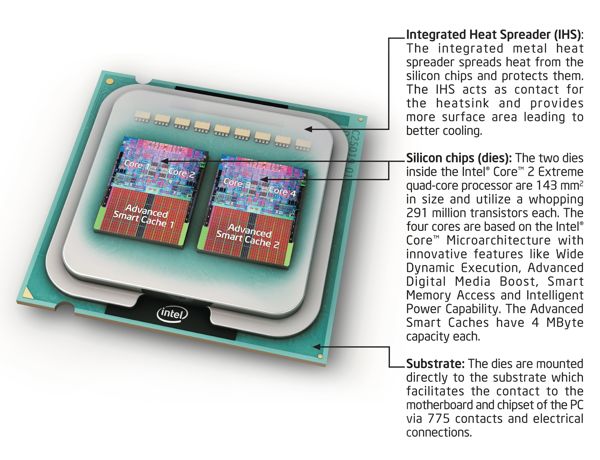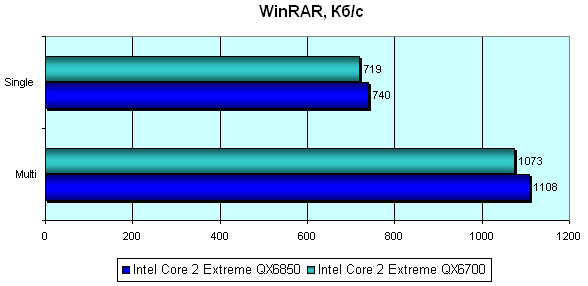All you need to know about your products!

| 3DNews Vendor Reference English Resource - All you need to know about your products! |
||||||
 |
||||||
|
|
||||||
Intel Core 2 Extreme QX6850: first impressionsAuthor:Date: 16/07/2007  So, here comes the time we raise the standards in the Intel's CPU sector. Today, we are introducing a review of Intel's new quad-core CPU of the "extreme" series - Intel Core 2 Extreme QX6850, reporting its capabilities and briefly the test results, as well as reminding the forthcoming updates in Intel's CPU line.
The Extreme series processors can hardly be referred to as belonging to the mass category – even after some time once they appear on sales, their prices are reluctant to go down, and by that time something new of comparable specifications comes up which is much cheaper. Primarily, the goal of releasing Extreme chips is to demonstrate the power that Intel's technologies have attained, provide the opportunity to run in-depth experiments and explore the architectural capabilities of the new CPUs and chipsets at test labs. Anyway,to some extent the Extreme series can be called a product for extreme users, overclockers, and simply well-to-do buyers who want all here and now. But for engineering tests the Extreme chips are of a different value: they are normally used to trial-run something new. On the other hand, such chips are normally shipped with the multiplier unlocked, which lets run a series of exciting comparative experiments, because CPUs like these are superb at overclocking - both in the multiplier and the bus.  That was the case with Core 2 Extreme X6800 (Conroe XE core) presented in July 2006 as a replacement to the previous single-core and dual-core flagships Pentium Extreme Edition which differed from the "regular" Core 2 Duo in grater clock speeds and the FSB multiplier unlocked. We can also recall the release of the first 4-core CPU of the extreme series – 2.67 GHz Intel Core 2 Extreme QX6700 (Kentsfield XE, November 2006) which in fact appeared to be two Conroe XE cores of Core 2 Extreme X6800 on a single bus with the multiplier unlocked.  What is the newly-born extreme Intel Core 2 Extreme QX6850 remarkable for? Above all, we should note that we mean the Kentsfield core with the TDP 130 W (in fact, doubled TDP of the original Core 2 Duo cores). The new Core 2 Extreme QX6850 chip, by analogy with the predecessors, is a representative of the Quad Core Technology line and appears to be two Core 2 Duo chips with the shared bus under a common "lid" LGA775. The overall L2 cache size has remained the same – 8 MB (2 ? 4MB). This CPU supports a number of technologies customary for this architecture - MMX, SSE, SSE2, SSE3, Enhanced Intel SpeedStep Technology (EIST), Intel 64, XD bit, iAMT2 (Intel Active Management), Intel VT (Virtualization Technology), Trusted Execution Technology.  The clock speed of the new CPU has been raised to 3.0 GHz, but most importantly it is the first chip with a core like that which supports FSB 1333 MHz. The area of the chip remained the same - 2 x 143 mm2. As compared to its predecessor, Core 2 Extreme QX6800, which offers the clock speed 2933 MHz, supports FSB 1066 MHz, has the multiplier11?, core voltage 1.1 - 1.372 V and TDP 130 W, the multiplier in the new CPU Core 2 Extreme QX6850 has been changed to 9?, which with the respective 1333 MHz bus gives the clock speed 3000 MHz; while the other specifications of the chips, including the stepping G0, being the same. This also applies to the exterior: it doesn't make sense bringing in the photo of the front side of the new CPU with the ? "Confidential" label, whereas photos of the chips taken on the side of contact pads will unlikely let you guess without additional explanation as to on which side there is QX6850 and where the QX6700 which took part in today's tests.  For the mainstream sector, Intel is planning a release of CPUs of the Core 2 Duo E6x50 series which also support FSB 1333 MHz at a much lower price than that of the Extreme series. In fact, it's just Core 2 Extreme QX6850 which now becomes a "nominal CPU" for experiments and making the most of forthcoming motherboards based on the new generation of top-end representatives of the Intel 3 Series (Bearlake) chipsets- Intel X38.  Henceforth, the line of CPUs on the Kentsfield core looks like this:
It should be noted that closer to the end of the year Intel intends to launch a release of "genuine" (not compound) 4-core Core 2 Extreme processors of the working name Yorkfield. According to the preliminary data, the chips will be based on the Penryn architecture, support FSB 1333 MHz and be manufactured following the 45 nm process technology.  This is about all with the introduction, so we'd better get round to the experiments. For those who are interested to refresh the knowledge of the Kentsfield architecture and the results of practical tests of the previous Core 2 Extreme QX chips, we can recommend a number of out previous publications on this and related topics:
Now that we found out that the differences between the new Core 2 Extreme QX6850 and the former leader Core 2 Extreme QX6800 are about support for the FSB 1333 MHz (instead of 1066 MHz) and secondly about the multiplier which is now equal to 9? (versus 11? in QX6800 and 10? in QX6700), which in in the end affects the increase of the clock speed up to 3.0 GHz (versus 2.93 in its predecessor, and 2.66 GHz in QX6700).   Test configuration
Needless to say, it would be a good idea to present an investigation of the overclocking capability of QX6850 as well as QX6800 which is close at the clock speeds, but unfortunately because of the shortage of time we have to be confined with the scope of the tests. The specifics of the test configuration does not let us run a detailed research and adjust the CPU clock speeds. So we have to merely promise a presentation of detailed results in the forthcoming publications. Therefore, our today's task made more complex due to the scarce volume of test results is actually not about the re-evaluation of leadership on the market of desktop PCs which has belonged to Core 2 Extreme QX6800 even without today's CPU in question. Today, we won't be able to estimate the advantages which are seen on using a CPU of the higher system bus speed 1333 MHz. Of course, we won't be able to compare processors of different clock speeds in a "brute-force" way - we only have to estimate the "percentage" of performance scattering of results for the chips QX6700 and QX6850 at the most characteristic test applications. Again, we won't be able to take the 20% difference in FSB speeds as the reference, or ~12% difference in clock speeds (and even to account for the different multipliers at the same time!) - the times of a linear "megahertz races" are well in the past. So today we are publishing the data which is absolute and weakly connected to the possibility to compare data on QX6850, or, if you like, a data template for detailed comparison. First, synthetic benchmarks. The CPU test integrated into the 3DMark 2006.   The key CPU tests of SiSoft Sandra 2007 Lite.   Tests of matrix multiplication following the AES algorithm of ScienceMark.  The key tests in CrystalMark.  Encoding video data with Windows Media Encoder.  Finally, estimation of data compression rate with benchmarks integrated into WinRAR and 7ZIP.   Repeating it again: today, there can't be any quantitative comparative data on comparing the results of CPU tests which are so different at clock speeds and FSB speeds. However, some interesting results can be seen even from today's material. For instance, the maximum difference is seen in video encoding and archiving - perhaps because these tests are originally optimized for multi-core CPUs. Also impressive is the gap in results in a number of synthetic tests, but we would need an additional investigation to find out which parameter made the most contribution to the performance boost - the clock speed or the FSB speed. Of course, there were no surprises: in any case, Intel Core 2 Extreme QX6850 will now occupy the top-ranking position in the hierarchy of the company's chips for desktop PCs. It is highly probable that for some time it will be able competing on par with new "non-extreme" novelties with FSB 1333 MHz or, quite possibly, clock speeds over 3 GHz due to the unlocked multiplier, the adjustability of the bus speed, and other overclocking options. By the way, according to some information that has appeared in the Internet, QX6850 has proved successful at overclocking to clock speeds over 5 GHz. A more detailed investigation into Intel Core 2 Extreme QX6850 at our lab will certainly reveal its overclocking capability, experiments with DDR3 memory, and most importantly will refine the numerical gap of the new flagship from its brethren and the most immediate competitors by AMD. Hopefully, we won't have to wait long to the continuation. |
|
|||||